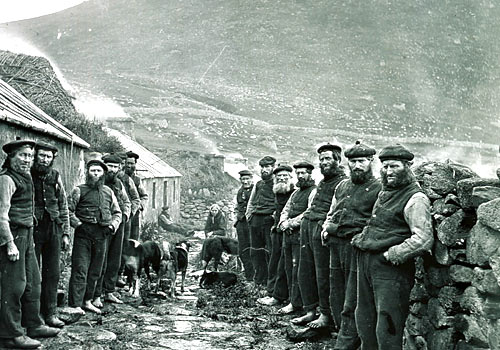I bought a book - The Life & Death of St Kilda, by Tom Steel - because I thought a friend would enjoy it. I hadn’t even meant to read it, but, having scanned the first chapter, I couldn’t stop. It’s a fascinating study of this remote Atlantic outpost, 110 miles off the west coast of Scotland, and beautifully written. It vividly depicts the life of the islanders: as perilous and precarious an existence as can be imagined in these British Isles. St Kilda was typically cut off, by high seas and storms, for nine months each year. They had no-one to rely on but themselves.
St Kildans relied for food on gannets, fulmars and puffins - ensnared by men abseiling down steep cliff-faces on ropes. The birds were brought back to the village and divided up equitably, so that every family had enough for their needs. The birds were eaten fresh, often with potatoes; the rest were salted, or, if no salt was available, air-dried, to provide food throughout the winter months. Crops other than potatoes were tried, but with limited success. There were no trees on the archepeligo of tiny islands; no vegetation grew taller than a cabbage. Islanders had sheep and a few cows, but no horses.
They never saw a bath, or a flush toilet. Hygiene wasn’t a priority. According to the author, “Plates, if they were used at all, were cleaned by the women wiping them over with a corner of their blue skirts”.
Divorce was unknown on St Kilda; marriage was for life. There was no crime, and no locks on the doors. None of the islanders could swim. They had little money… and little use for it. Even their rents were paid ‘in kind’, often with the knitted articles the women made. The islanders paid no income tax (because no-one ever tried to collect it) and voted in no election. They had a parliament, of sorts: every day except Sunday the men would meet on ‘main street’, between houses 5 and 6, to decide what needed doing… and who would do it (the author notes that “The men arrived in their own time, and, at the meeting, according to observers, everyone appeared to talk at once”).
There was no doctor on St Kilda. A nurse who visited in the 1920s reported that illness and poor diet were making life ever more difficult for the islanders. She recommended that they should be evacuated back to mainland Scotland. There were probably never more than 200 people living on St Kilda; by the time of her visit that number had declined to just 38. Some islanders voted to leave; others had to be persuaded. All were taken off the island, along with their meagre belongings, in 1930. In each house a Bible was left, open at Exodus.

No comments:
Post a Comment